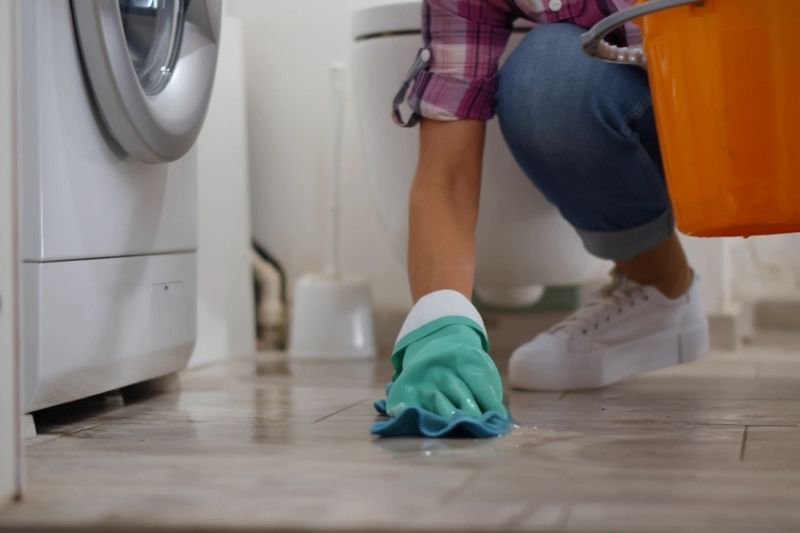Washing Machine Leaking From Bottom

Washing machines are an essential part of our daily lives, making laundry day a breeze. However, when they start leaking, it can be a nightmare. One of the most common issues with washing machines is leaking from the bottom. This can be caused by a variety of factors, including worn-out seals, loose connections, or clogged drains. In this article, we will delve into the possible causes of a washing machine leaking from the bottom and provide you with a step-by-step guide on how to diagnose and fix the issue.
Key Points
- Identify the source of the leak to determine the best course of action
- Regular maintenance can help prevent leaks from occurring
- Check the user manual for specific instructions on how to troubleshoot and repair your washing machine
- Consider consulting a professional if you are not comfortable with DIY repairs
- Prevent future leaks by checking and replacing worn-out parts regularly
Causes of a Washing Machine Leaking from the Bottom

A washing machine leaking from the bottom can be caused by a variety of factors. Some of the most common causes include:
- Worn-out seals: Over time, the seals around the washing machine’s doors, lids, or drain pumps can become worn out, causing water to leak out.
- Loose connections: Loose connections between the washing machine’s hoses, drain pumps, or other components can cause water to leak out.
- Clogged drains: A clogged drain pump or filter can cause water to back up and leak out of the washing machine.
- Cracked or damaged tub: A cracked or damaged tub can cause water to leak out of the washing machine.
- Improper installation: If the washing machine is not installed correctly, it can cause water to leak out.
Diagnosing the Leak
To diagnose the leak, you will need to inspect the washing machine and its components. Here are some steps to follow:
- Turn off the washing machine and unplug it from the power source.
- Check the washing machine’s drain pump and filter for any blockages or debris.
- Inspect the seals around the doors, lids, and drain pumps for any signs of wear or damage.
- Check the hoses and connections for any signs of leakage or damage.
- Look for any signs of water damage or mineral deposits around the washing machine.
| Component | Inspection Point |
|---|---|
| Drain pump | Check for blockages or debris |
| Seals | Inspect for signs of wear or damage |
| Hoses | Check for signs of leakage or damage |
| Tub | Inspect for cracks or damage |

Fixing the Leak

Once you have diagnosed the cause of the leak, you can start fixing it. Here are some steps to follow:
- Replace any worn-out seals or damaged components.
- Tighten any loose connections or hoses.
- Clear any blockages or debris from the drain pump or filter.
- Repair or replace any damaged or cracked components, such as the tub.
- Reinstall the washing machine according to the manufacturer’s instructions.
Preventing Future Leaks
To prevent future leaks, it is essential to regular maintenance on your washing machine. Here are some tips:
- Check and replace worn-out parts regularly: Regularly inspect the washing machine’s seals, hoses, and other components for signs of wear or damage.
- Clean the drain pump and filter regularly: Clean the drain pump and filter regularly to prevent blockages and debris buildup.
- Run regular maintenance cycles: Run regular maintenance cycles to clean the washing machine and prevent buildup.
- Check the user manual: Check the user manual for specific instructions on how to maintain and troubleshoot your washing machine.
How often should I check my washing machine for leaks?
+It is recommended to check your washing machine for leaks every 3-6 months, depending on usage.
Can I fix a washing machine leak myself?
+Yes, you can fix a washing machine leak yourself, but it is recommended to consult a professional if you are not comfortable with DIY repairs.
How much does it cost to repair a washing machine leak?
+The cost of repairing a washing machine leak can vary depending on the cause and severity of the leak, as well as the cost of replacement parts and labor.
In conclusion, a washing machine leaking from the bottom can be a frustrating issue, but it can be diagnosed and fixed with the right tools and knowledge. By following the steps outlined in this article, you can identify the cause of the leak and take the necessary steps to repair it. Remember to always follow safety precautions when working with electrical appliances and to consult a professional if you are not comfortable with DIY repairs.



